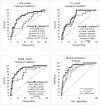Robust prediction of mortality of COVID-19 patients based on quantitative, operator-independent, lung CT densitometry
- PMID: 33971530
- PMCID: PMC8084622
- DOI: 10.1016/j.ejmp.2021.04.022
Robust prediction of mortality of COVID-19 patients based on quantitative, operator-independent, lung CT densitometry
Abstract
Purpose: To train and validate a predictive model of mortality for hospitalized COVID-19 patients based on lung densitometry.
Methods: Two-hundred-fifty-one patients with respiratory symptoms underwent CT few days after hospitalization. "Aerated" (AV), "consolidated" (CV) and "intermediate" (IV) lung sub-volumes were quantified by an operator-independent method based on individual HU maximum gradient recognition. AV, CV, IV, CV/AV, IV/AV, and HU of the first peak position were extracted. Relevant clinical parameters were prospectively collected. The population was composed by training (n = 166) and validation (n = 85) consecutive cohorts, and backward multi-variate logistic regression was applied on the training group to build a CT_model. Similarly, models including only clinical parameters (CLIN_model) and both CT/clinical parameters (COMB_model) were developed. Model's performances were assessed by goodness-of-fit (H&L-test), calibration and discrimination. Model's performances were tested in the validation group.
Results: Forty-three patients died (25/18 in training/validation). CT_model included AVmax (i.e. maximum AV between lungs), CV and CV/AE, while CLIN_model included random glycemia, C-reactive protein and biological drugs (protective). Goodness-of-fit and discrimination were similar (H&L:0.70 vs 0.80; AUC:0.80 vs 0.80). COMB_model including AVmax, CV, CV/AE, random glycemia, biological drugs and active cancer, outperformed both models (H&L:0.91; AUC:0.89, 95%CI:0.82-0.93). All models showed good calibration (R2:0.77-0.97). Despite several patient's characteristics were different between training and validation cohorts, performances in the validation cohort confirmed good calibration (R2:0-70-0.81) and discrimination for CT_model/COMB_model (AUC:0.72/0.76), while CLIN_model performed worse (AUC:0.64).
Conclusions: Few automatically extracted densitometry parameters with clear functional meaning predicted mortality of COVID-19 patients. Combined with clinical features, the resulting predictive model showed higher discrimination/calibration.
Keywords: COVID-19; CT; Lung densitometry; Respiratory distress syndrome.
Copyright © 2021 Associazione Italiana di Fisica Medica. Published by Elsevier Ltd. All rights reserved.
Figures




Similar articles
-
Atlas-based lung segmentation combined with automatic densitometry characterization in COVID-19 patients: Training, validation and first application in a longitudinal study.Phys Med. 2022 Aug;100:142-152. doi: 10.1016/j.ejmp.2022.06.018. Epub 2022 Jul 4. Phys Med. 2022. PMID: 35839667 Free PMC article.
-
Radiomics Analysis of Computed Tomography helps predict poor prognostic outcome in COVID-19.Theranostics. 2020 Jun 5;10(16):7231-7244. doi: 10.7150/thno.46428. eCollection 2020. Theranostics. 2020. PMID: 32641989 Free PMC article.
-
Incubation period, clinical and lung CT features for early prediction of COVID-19 deterioration: development and internal verification of a risk model.BMC Pulm Med. 2022 May 12;22(1):188. doi: 10.1186/s12890-022-01986-0. BMC Pulm Med. 2022. PMID: 35549897 Free PMC article.
-
A nomogram based on the quantitative and qualitative features of CT imaging for the prediction of the invasiveness of ground glass nodules in lung adenocarcinoma.BMC Cancer. 2024 Apr 9;24(1):438. doi: 10.1186/s12885-024-12207-8. BMC Cancer. 2024. PMID: 38594670 Free PMC article.
-
Thoracic imaging tests for the diagnosis of COVID-19.Cochrane Database Syst Rev. 2020 Sep 30;9:CD013639. doi: 10.1002/14651858.CD013639.pub2. Cochrane Database Syst Rev. 2020. Update in: Cochrane Database Syst Rev. 2020 Nov 26;11:CD013639. doi: 10.1002/14651858.CD013639.pub3. PMID: 32997361 Updated.
Cited by
-
Artificial intelligence for differentiating COVID-19 from other viral pneumonias on CT: comparative analysis of different models based on quantitative and radiomic approaches.Eur Radiol Exp. 2023 Jan 24;7(1):3. doi: 10.1186/s41747-022-00317-6. Eur Radiol Exp. 2023. PMID: 36690869 Free PMC article.
-
Residual lung damage following ARDS in COVID-19 ICU survivors.Acta Anaesthesiol Scand. 2022 Feb;66(2):223-231. doi: 10.1111/aas.13996. Epub 2021 Nov 17. Acta Anaesthesiol Scand. 2022. PMID: 34758108 Free PMC article.
-
DW-UNet: Loss Balance under Local-Patch for 3D Infection Segmentation from COVID-19 CT Images.Diagnostics (Basel). 2021 Oct 20;11(11):1942. doi: 10.3390/diagnostics11111942. Diagnostics (Basel). 2021. PMID: 34829289 Free PMC article.
References
MeSH terms
LinkOut - more resources
Full Text Sources
Other Literature Sources
Medical
Research Materials

